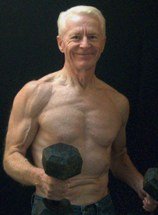| Back to Back Issues Page |
 |
|
The Gray Iron Fitness Newsletter, Issue #155 Lifespan vs. Healthspan February 01, 2015 |
Hi
February 1, 2015
In this newsletter . . . Lifespan vs. HealthspanShould you train to failure?
Lifespan vs. HealthspanRecently, Scientific American* published an article suggesting that living longer doesn’t necessarily mean living better. It’s a lesson learned from the tiny roundworm called C. elegans, a common workhorse in basic biology lab work.Here’s the story. Researchers gathered two groups of roundworms. One group was put on a calorie-restricted diet, the other not. What they found was they could extend the lifespan of the worms on a very low calorie diet. But the “healthspan” — that is the period of worm fitness and health — was the same in both groups. In other words, the extended lifespan did not come with extended fitness and health. The longer-living worms spent the extended period of their lives in a diminished state — with less mobility and stress resistance. Of course aging worms are not aging people. But if the findings do extend to people, as some scientists suspect, then life-extension efforts may not result in a better old age, just more years of frailty. How much life extension would any of us want if the added years were to be spent in a nursing home? Jack LaLanne used to say he didn’t care so much how long he lived (though he died at 96). What he most cared about was his quality of life while he lived. The purpose of following a fitness lifestyle evolves as we age. As young people our thrust may have been to develop great strength, or tremendous endurance, or even body perfection. To some extent, such desires may remain as seniors; but to a much lesser degree, I would think. More important, our primary objective as we age should be to extend our healthspan. That is, to stay as fit and healthy as possible for as long as possible. And here is where resistance exercise comes in: free weights, machines, and/or resistance bands are the antidote to decrepitude. A primary culprit in old age is the withering of muscle that robs the elderly of strength and, eventually, their independence. While weights, along with some cardiovascular work and flexibility movements, preserve the quality of youth like nothing else. Discover more about the miracle of resistance exercise here. * Founded in 1845, Scientific American is the oldest continuously published magazine in the United States. It is a leading source for science, technology information and policy for a general audience. If you like the newsletter, we're making it easy to share it . . . Should you train to failure?Most of the following is from Living the Fitness Lifestyle.Personally, training to failure on any kind of regular basis always seemed like a bad idea. I know there are exceptions to the rule. But I’ve tried it a few times and found that it soon takes its toll on my mind and body. I simply cannot sustain pushing myself to the absolute limit workout after workout. And I think most people are the same. However, I was looking at an article in Men’s Health and the author described two different types of training to failure. One type is training to absolute failure, and the other type is training to technical failure. He defined training to absolute failure as not being able to complete another rep, no matter what. While training to technical failure is that point when your body posture must change to complete the movement. In other words, when you have to cheat by leaning or swinging forward or back, or you can’t control the speed of the weight you are lifting. Now that makes a little more sense to me than going to absolute failure. Still, I always liked what Bill Pearl says about the concept. I’m paraphrasing, but Pearl says to end a set when you could do one or two more reps, if you really had to. Finish your workouts leaving a little gas still in the tank. Train don’t strain used to be the advice in the old muscle building courses. That’s still pretty good advice today. 
Newsletter Policy The Gray Iron Fitness Newsletter is a free publication sent twice monthly to subscribers. The purpose is to provide honest and realistic fitness information for people age 50 and above. I have never been paid or received compensation of any kind to write a positive review or endorse a product. If I say that I personally use a product or service, it is because I find value in it and have paid for it with my own money. Like newspapers, magazines and television, this newsletter and my web site contain advertising and marketing links. Naturally, I am compensated for these. The newsletter and web site provide information to help users establish and maintain a fitness lifestyle. But fitness information is not the same as fitness advice, which is the application of exercise and dietary practices to an individual's specific circumstances. Therefore, always consult with your physician for assurance that fitness information, and your interpretation of it, is appropriate for you. Your comments and questions are always appreciated. Simply click on the "Reply" bottom. |
| Back to Back Issues Page |